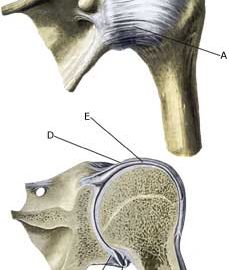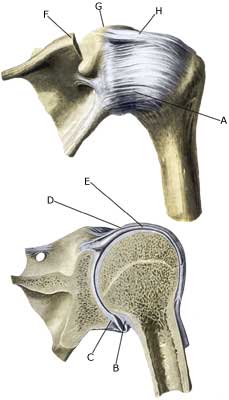|
||
|
||
| Cause: In case of a powerful load the caput on the upper arm can be pushed or torn completely or partially out of the articular surface on the shoulder blade. This always leads to ruptures or tearing of the joint-capsule. Additionally, ruptures of the ligaments and muscles may occur, meniscus damage (labrum glenoidale) and in some cases cartilage and bone is knocked off the articular surfaces (Bankart, Hill-Sach).
Symptoms: In case of total luxation there is immediate pain in the shoulder after a powerful load or fall. Mobility in the arm is greatly reduced due to pain. It will often (but not always) be visible on the shoulder that it is out of joint. In other cases only partial luxation occurs (subluxation), dislodging the capitulum only brieftly, and then sliding back into place. The ruptures of the joint-capsule and ligaments can lead to chronic looseness in the shoulder, causing repeated dislodging of the shoulder, which can be felt as a sudden pain and reduction of strength (“Dead Arm”), when the arm is held over and behind the head (abducated and outwards rotated) (article). Acute treatment: Click here. Examination: Medical examination is required in all cases where a total or partial luxation of the shoulder is suspected, often combined with special X-ray examinations or CT- or MR-scanning (article). Treatment: Most cases of partial luxation and looseness in the shoulder can be rehabilitated. The rehabilitation seeks to strengthen the muscles around the shoulder joint (article). In some cases of total luxation and in most cases where luxation is combined with other injuries like meniscus or cartilage/bone damage surgery will be advised. If, in spite of rehabilitation, (partial) luxation continues to occur, the possibility of surgery should be re-evaluated (article). Rehabilitation of partial, not operated, luxation of the shoulder joint (subluxation) Complications: After (partial) luxation in the shoulder, a looseness of the shoulder joint often occur, which increases the risk of follow-on injuries in the form of: |


